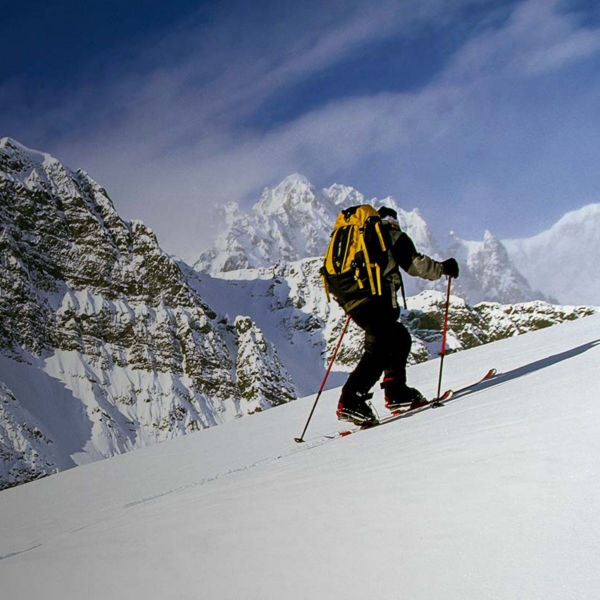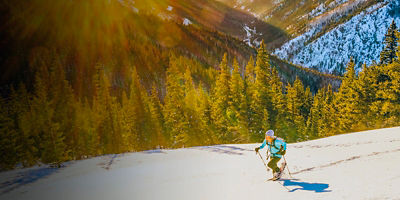
Downhill skiing isn’t the only way to venture into the winter wilderness. Cross-country (aka Nordic) skiing is a mellower, less adrenaline-fueled option that lets you escape the alpine resort crowds and get a killer aerobic workout to boot. The equipment is simple, trail passes are free or cheap, and it’s easy on the joints.
Cross-country skiing contains two broad categories: classic and skate skiing. Classic skiing typically involves using a back-and-forth kick-and-glide motion on groomed tracks, while skate skiing uses a rhythmic skating motion on wider groomed trails. There’s also backcountry cross-country skiing, a bridge between classic or skate skiing and alpine touring, which takes you off trail and often involves steeper terrain. Each style has its own outfitting needs with specific gear.
In this article, you’ll learn:
- How to select the hard-good essentials needed to start classic cross-country skiing, including skis, poles and boots
- To differentiate between the binding styles for classic cross-country and skate skis
- Gear considerations for skate skiing and backcountry cross-country skiing
Classic Cross-Country Skiing Gear
The classic style is probably what you think of when you picture cross-country skiing.
Skis
Cross-country skis are light and long (for gliding efficiency) and narrow, with little sidecut, to glide straight and fit into groomed tracks. They’re designed with a springy double-camber flex that arches the ski when it’s unweighted, elevating the area underfoot. Once weighted, the ski flattens and the middle third hits the snow, where a scaled or waxed base provides grip while the other ski glides forward. Many models offer progressive flex patterns for better power transmission and easier kicking without diminishing the glide. Choose between the main classic cross-country ski types.
Waxable: These skis require applying sticky kick wax to the “wax pocket,” or middle third of the ski beneath your foot to gain traction when you stride forward. While this requires more maintenance (including using different waxes for the day’s temperature and snow conditions, as well as periodic base cleaning), many skiers want waxable skis so they can precisely match the day’s snow. Hint: Spend the time getting the wax right for the conditions to make your outing more efficient and enjoyable; too warm a wax and you’ll stick when gliding, too cold and you’ll slip backwards when striding.
Waxless: Waxless skis feature scales on the kick zone for traction, negating the need to apply kick wax. They’re much easier to use than waxable skis: Simply put them on and go. They’re also great if the conditions make choosing the right wax tricky, and recent advancements have made them nearly as good as waxable skis.
Skis with skins: A new breed of cross-country ski comes with built-in skins (like Madshus’ IntelliGrip system) for traction. Like climbing skins used for backcountry touring, their mohair is designed to glide one way and grip the other. Unlike backcountry skins, this alternative is thinner and shorter (affixed just in the kick zone), with some attached permanently and others (like a model from Salomon) interchangeable for stronger grip. On the downside, you forsake a bit of glide.
Ski Sizing: Cross-country ski length is based on your weight, height, and experience level. Shorter skis are easier to manage and turn, but offer less glide and stability; longer skis offer better glide, but are harder to handle. Check manufacturer recommendations for length, as brands vary. Hint #1: Go about 25 centimeters longer than you are tall. Hint #2: Slide a piece of paper beneath the kick zone and weight the ski. If the paper can slide out, the ski is too long; if it can’t, the ski is about right.
Poles
Made from aluminum, fiberglass or other composites, classic Nordic poles are shorter, softer and more flexible than skate poles. Pole straps should fit easily into your gloves, allowing a modicum of support for additional propulsion. General sizing rule: They should be about armpit-high.
Boots
Classic Nordic boots have flexible uppers to accommodate ankle movement when striding forward, plus stiff soles for stability. For torsional rigidity, most soles are either plastic or carbon, depending on your price and performance requirements; carbon is lighter, stiffer, and more expensive. Most also have gaiters over the tongue to thwart snow build-up. Try them on beforehand: They should feel snug, but not tight, with your toes barely touching the end and your heel held in place. Note: Make sure they’re compatible with your Nordic bindings.























